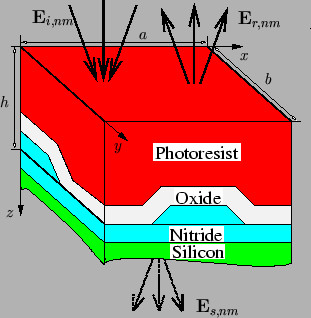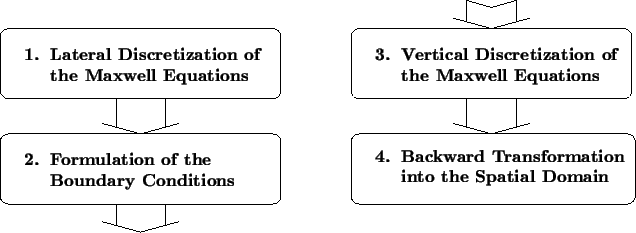



Next: 6.2 Lateral Discretization of
Up: 6.1 Fundamentals
Previous: 6.1.1 Problem Formulation
In the previous section it is shown that the time-harmonic Maxwell equations in
the form of (6.5) have to be solved. The main difficulties
arise from the inhomogeneous permittivity
 (x)
in (6.6). Otherwise the Maxwell equations could easily be
reduced to the Helmholtz equation (4.2) which has a
mathematically much simpler structure and can thus be solved very efficiently.
However, we have to directly tackle the Maxwell equations. In this section we
will outline the main ideas behind the differential method. As the choice of
the simulation domain and the BCs resulting thereof are of
crucial importance for the operation principle we will discuss them first.
(x)
in (6.6). Otherwise the Maxwell equations could easily be
reduced to the Helmholtz equation (4.2) which has a
mathematically much simpler structure and can thus be solved very efficiently.
However, we have to directly tackle the Maxwell equations. In this section we
will outline the main ideas behind the differential method. As the choice of
the simulation domain and the BCs resulting thereof are of
crucial importance for the operation principle we will discuss them first.
The differential method requires a rectangular-shaped simulation
domain, i.e.,
 |
(6.7) |
Inside the simulation domain arbitrary inhomogeneous and nonplanar regions can
be simulated, above vacuum is situated, and below multiple planar homogeneous
layers form a stratified medium. A schematic of a typical formation is shown in
Figure 6.1. We now assume that the rectangular domain is
one period
(a x b x h) of a laterally periodic geometry.
Hence the BCs in lateral directions require equal field
values at the left and right boundaries as well as in the front and at the back
of the structure (cf. Figure 6.1), i.e.,
 |
(6.8) |
On top planar waves
Ei, nm are incident that are modulated by the
mask and thus carry the information to be printed. Due to the abrupt change of
the optical properties at the air/resist interface reflected waves
Er, nm occur. Part of the incident light penetrates into the
wafer and propagates through it. At the bottom either lie multiple
planar homogeneous layers or only the substrate that is assumed to be
infinitely extended since it is typically highly absorptive like silicon.
In the former case waves are incident also at the bottom side of the simulation
domain since they are reflected within the stratified medium. This situation can
be treated analytically using the methods presented in Appendix C.
However, in the bottom-most layer, i.e., the substrate, only outgoing waves
Es, nm are emitted. In the latter case this situation occurs
directly below the simulation domain, which slightly simplifies the formulation
of the BCs. Both situations will be discussed below.
Figure 6.1:
Simulation
domain of the differential method. The simulation domain is assumed
to be one period
(a x b x h) of a laterally periodic
structure. In the example given it consists of the inhomogeneous
resist, the nonplanar oxide, and the nonplanar part of the nitride. The
planar part of the nitride forms with the infinitely extended silicon
substrate a stratified medium. Above the resist we have to consider
incident
Ei, nm and reflected
Er, nm waves,
whereas below the nitride layer only outgoing waves
Es, nm
travel into the silicon substrate.
|
|
The discretization employed in the differential method basically involves
four consecutive steps. In the following enumeration each of them is briefly
described:
- 1.
- Lateral Discretization of the Maxwell equations. The dependence
of the EM field on the lateral x- and y-coordinates is expressed
by Fourier series, i.e., a laterally periodic field distribution is
assumed,
 |
(6.9) |
A prerequisite for that are a periodic excitation at the
top of the structure as well as periodic material properties. Since
both the mask and the wafer are assumed to be periodic either
requirement is fulfilled and the Fourier expansion of the field
is justified. Insertions of these expansions into the time-harmonic
Maxwell equations transform the PDEs into
ordinary ones. The unknowns of these equations are the Fourier
coefficients of the lateral electric and magnetic field vector components.
- 2.
-
Formulation of the Boundary Conditions. The BCs for the system of
ODEs thus obtained are found
by matching the Fourier expansions valid inside the simulation domain with
the Rayleigh expansions valid outside. Algebraic equations are set
up that relate each pair of Fourier coefficients belonging together.
Exactly half of the BCs are found at the top and at the
bottom of the simulation domain. Hence we have to solve a two-point BVP.
- 3.
-
Vertical Discretization of the Maxwell equations. The vertical
discretization of this two-point BVP is accomplished
by the memory-saving shooting method. This algorithm can be implemented
in a particularly efficient way in the situation of partially coherent
illumination since the extra numerical costs cause multiple right-hand
sides in the final discretized system and are therefore negligible in
comparison to the overall costs. Additionally, sophisticated numerical
techniques enforce good convergence in even strongly absorptive media.
- 4.
- Backward Transformation into Spatial Domain. The solution
vector of the ODE system comprises the
vertically dependent Fourier coefficients. These coefficients have to be
transformed back into the spatial domain. In case of partially coherent
illumination the various contributions representing one source point have
to be superposed incoherently to build up the absorbed light intensity
within the photoresist needed for the exposure/bleaching model
(cf. Abbe's method discussed in Section 4.3.1).
Detailed information on the first three steps is given in the following
three sections. The last step is obvious and is therefore not discussed in an
own section. In Figure 6.2 the discretization procedure
is illustrated graphically.
Figure 6.2:
Discretization
procedure of the differential method. Basically four consecutive
steps are involved. The lateral discretization is performed by
transforming the partial differential equations into the frequency
domain. Once the boundary conditions are established, the obtained
ordinary differential equation system is numerically solved. Finally,
the calculated Fourier coefficients are transformed back to the
spatial domain.
|
|




Next: 6.2 Lateral Discretization of
Up: 6.1 Fundamentals
Previous: 6.1.1 Problem Formulation
Heinrich Kirchauer, Institute for Microelectronics, TU Vienna
1998-04-17

